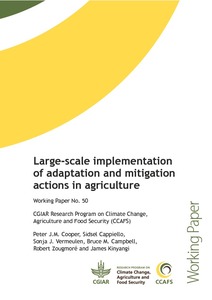This 2012 Global Food Policy Report is the second in an annual series that provides an in-depth look at major food policy developments and events. Initiated in response to resurgent interest in food security, the series offers a yearly overview of the food policy developments that have…
This 2012 Global Food Policy Report is the second in an annual series that provides an in-depth look at major food policy developments and events. Initiated in response to resurgent interest in food security, the series offers a yearly overview of the food policy developments that have…
The environmental consequences of agriculture are of growing concern. One example of these consequences is the effect of agricultural pollutants on the Great Barrier Reef (GBR), a world heritage-listed ecosystem lying off the tropical north-eastern coast of Australia. Pollutants from…
In this study we analyzed the large scale spatial patterns of river pH, alkalinity, and CO₂ partial pressure (PCO₂) in North America and their relation to river catchment properties. The goal was to set up empirical equations which can predict these hydrochemical properties for non-monitored…
Whether ignited by lightning or by Native Americans, fire once shaped many North American ecosystems. EuroâAmerican settlement and 20thâcentury fire suppression practices drastically altered historic fire regimes, leading to excessive fuel accumulation and uncharacteristically severe…
Groundwater is widely used as a source of drinking water in North America. However, it can be contaminated by microbial or chemical agents potentially hazardous to human health. In recent decades, governments have developed better knowledge of groundwater and established measures to protect and…
The family Centrarchidae is a principal and visible component of the ichthyofauna in most warmwater ecosystems in North America, and many of its species provide key recreational fisheries. We examined the significance of various local environmental factors to 13 centrarchid species in 53…
Trade liberalization has greatly accelerated the volume of traded agricultural products in past decades. As land resources become more limited in some countries, international trade plays an important role in compensating for land scarcity in these countries. This paper aims to measure and…
The National Park Service (NPS) and other land management agencies have interest in managing bison herds under ânaturalâ conditions; yet demographic features of natural populations are not well described. One solution to this issue involves the analysis of historical bison (Bison spp.) jump…
Biodiversity in rangelands is decreasing, due to intense utilization
for livestock production and conversion of rangeland into cropland;
yet the outlook of rangeland biodiversity has not been
considered in view of future global demand for food. Here we
assess the impact…
This is the rst paper that estimates the global land use change impact of growth of the bioenergy sector. Applying time-series analytical mechanisms to fuel, biofuel and agricultural commodity prices and production, we estimate the long-rung relationship between energy prices, bioenergy…
This paper identifies sixteen cases of large-scale actions in the agriculture and forestry sectors that have adaptation and/or mitigation outcomes, and distils lessons from the cases. The cases cover policy and strategy development (including where climate-smart objectives were not the initial…






